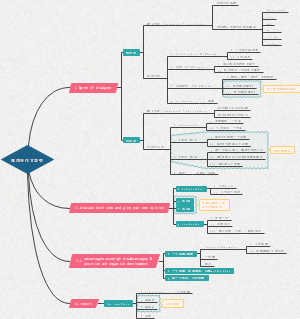导图社区 The Sentence
- 49
- 0
- 0
- 举报
The Sentence
这是一篇关于The Sentence的思维导图Imperative sentence: express a command/request
编辑于2023-02-06 11:50:17 浙江省- 英语writing
- 相似推荐
- 大纲
The Sentence
Complete Sentences and Sentence fragments
A Complete Sentence(an independent clause)
A complete sentence contains a subject, a predicate, and conveys a complete thought.
Subject: who or what the sentence is about; who or what is doing the action. [noun/pronoun]
Predicate: what the subject does or is; [the verb (action or state) and all that follows]
Sentence Fragmentsor Incomplete Sentences
A fragment is a a word group that lacks a subject or a verb and/or fails to express a complete thought.
1. Missing-Subject Fragments
2. Sentence Fragments Without a Verb
3. Dependent Clause Fragments
4. Added-Detail Fragments附加细节不完整句
5. -ing Fragments
6. -to Fragments
7. Descriptive phrases
Types of Sentences
Declarative, Interrogative, Imperative, and Exclamatory Sentences
According to Use Declarative sentence: make a statement Interrogative sentence: ask a question Imperative sentence: express a command/request Exclamatory sentence: express a strong feeling/emotion
Simple, Compound, Complex, and Compound-Complex Sentences
Simple: Sentences consist of a subject and a verb to form an independent clause.
Compound: Sentences consist of two or more independent clauses joined by a conjunction or semicolon. Each of these clauses could form a sentence alone.
Complex: Sentences consist of an independent clause and at least one dependent clause.
Compound-complex: Sentences consist of at least two independent clauses and one or more dependent clauses.
Loose, Periodic, Convoluted, and Centered Sentences
Parallel Constructions and Balanced Sentences
Short and Long Sentences
Effective Sentences
Variety
Beginning: vary sentence openings
Structure: vary sentence patterns
Length: vary sentence length
Conciseness
Omit unnecessary words and expressions
A sentence should contain no unnecessary words, a paragraph no unnecessary sentences. This requires not that the writer make all his sentences short, or that he avoid all detail and treat his subjects only in outline, but that every word tell.
Change clauses into phrases
Avoid unnecessary repetition
Use the active voice
The active voice is more concise than the passive.
Put statements in positive form
Use Predicate Adjectives
Do not state what sentence structure itself makes clear
Use Ellipses
Use Parallelism
Change sentence structures
Emphasis
Partial emphasis
Emphasis within the sentences (only to a word, or a group of words, within the sentence)
Total emphasis
Emphatic sentences (the entire sentence)
① The Short Sentence ② The Inverted Sentence ③ The Imperative Sentence ④ The Interrupted Sentence ⑤ The Periodic Sentence ⑥ The Rhetorical Question ⑦ Negative-Positive Restatementences
Coherence
What makes a sentence incoherent:
Faulty parallel constructions
Pronouns with ambiguous reference
Dangling or misplaced modifiers
Confusing shifts in person, number, voice, tense and mood.
Unity
Complete
Relevant / To the point
Run-On Sentences
A run-on sentence consists of two complete thoughts run together without adequate punctuation to signal the break between them.
Fused sentences
Fused sentences have no punctuation to mark the break between the two thoughts.
Comma Splice / Comma Fault
Comma faults (also called comma splices) are the most common kind of run-on sentences.
Four Ways to Correct Run-On Sentences
Method 1: Period and a Capital Letter
Method 2: Comma and a Joining Word
Method 3: Semicolon
A semicolon can be used with a transitional word and a comma to join two complete thoughts.
Method 4: Use subordination.









